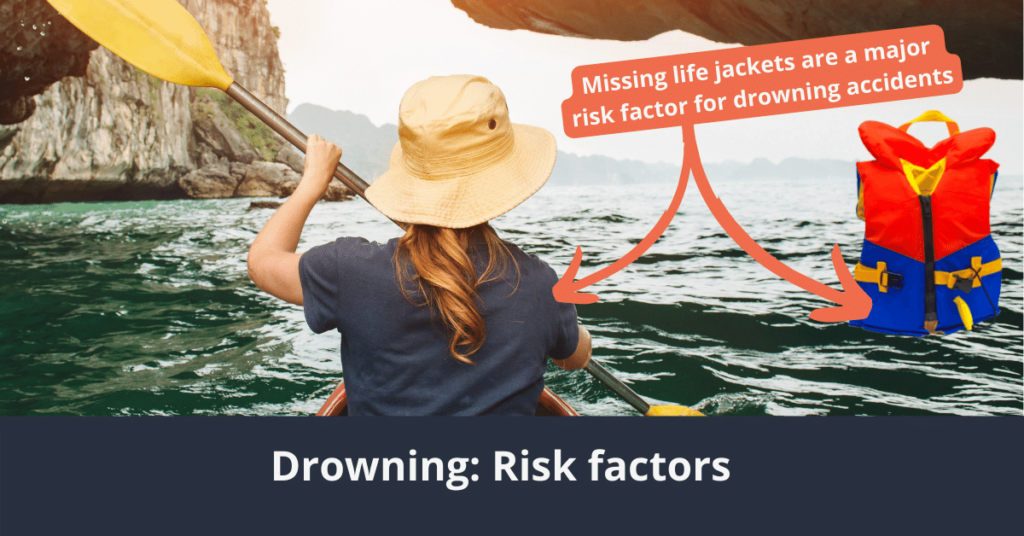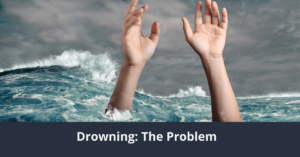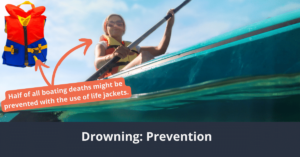Everything you will learn here
Lack of Swimming Ability
Many adults and children report that they can’t swim. 7,8
Research has shown that participation in formal swimming lessons can reduce the risk of drowning among children aged 1 to 4 years. 9,10
Lack of Barriers
Barriers, such as pool fencing, prevent young children from gaining access to the pool area without caregivers’ awareness.11
A four-sided isolation fence (separating the pool area from the house and yard) reduces a child’s risk of drowning 83% compared to three-sided property-line fencing.12
Lack of Close Supervision
Drowning can happen quickly and quietly anywhere there is water (such as bathtubs, swimming pools, buckets), and even in the presence of lifeguards.13,14
Where You Are
People of different ages drown in different locations. For example, most children ages 1-4 drown in home swimming pools.2
The percentage of drownings in natural water settings, including lakes, rivers and oceans, increases with age.2
More than half of fatal and nonfatal drownings among those 15 years and older (57% and 57% respectively) occurred in natural water settings.2
Failure to Wear Life Jackets
In 2010, the U.S. Coast Guard received reports for 4,604 boating incidents; 3,153 boaters were reported injured, and 672 died. Most (72%) boating deaths that occurred during 2010 were caused by drowning, with 88% of victims not wearing life jackets.15,16
Alcohol Use
Among adolescents and adults, alcohol use is involved in up to 70% of deaths associated with water recreation, almost a quarter of ED visits for drowning, and about one in five reported boating deaths.2,15,17
Alcohol influences balance, coordination, and judgment, and its effects are heightened by sun exposure and heat.17
Seizures and Disorders
For persons with seizure disorders, drowning is the most common cause of unintentional injury death, with the bathtub as the site of highest drowning risk.18
Next: The Research on Drowning Prevention
Go back to Part 1 The Problem
Continue with Part 3 Prevention
Sources
- Centers for Disease Control and Prevention, National Center for Injury Prevention and Control. Web-based Injury Statistics Query and Reporting System (WISQARS) [online]. [cited 2012 May 3]. Available from: URL: http://www.cdc.gov/injury/wisqars.
- CDC. Wide-ranging online data for epidemiologic research (WONDER). Atlanta, GA: CDC, National Center for Health Statistics; 2016. Available at http://wonder.cdc.gov.
- Cummings P, Quan L. Trends in Unintentional Drowning: The Role of Alcohol and Medical Care. JAMA, 1999; 281(23):2198-2202.
- Spack L, Gedeit R, Splaingard M, Havens PL. Failure of aggressive therapy to alter outcomes in pediatric near-drowning. Pediatric Emergency Care 1997; 13(2):98-102.
- Gilchrist J, Parker EM. Racial/ethnic disparities in fatal unintentional drowning among persons aged ≤29 years—United States, 1999–2010. MMWR 2014;63:421–6.
- Branche CM, Dellinger AM, Sleet DA, Gilchrist J, Olson SJ. Unintentional injuries: the burden, risks and preventive strategies to address diversity. In: Livingston IL, editor. Praeger handbook of Black American health (2nd edition): Policies and issues behind disparities in health. Westport (CT): Praeger Publishers; 2004. p. 317-27.
- Gilchrist J, Sacks JJ, Branche CM. Self-reported swimming ability in U.S. adults, 1994. Public Health Reports 2000;115(2–3):110–1.
- Irwin CC, Irwin RL, Ryan TD. Urban minority youth swimming (in)ability in the United States and associated demographic characteristics: toward a drowning prevention plan. Injury Prevention 2009; 15: 234-239.
- Brenner RA, Taneja GS, Haynie DL, Trumble AC, Qian C, Klinger RM, Klevanoff MA. Association between swimming lessons and drowning in childhood: A case-control study. Archives of Pediatrics & Adolescent Medicine 2009;163(3):203-10.
- Yang L, Nong QQ, Li CL, Feng QM, Lo SK. Risk factors for childhood drowning in rural regions of a developing country : a case-control study. Injury Prevention, 2007; 13:178-182.
- U. S. Consumer Product Safety Commission. Safety barrier guidelines for residential pools [online]. [cited 2023 August 23rd]. Available from URL: https://www.cpsc.gov/s3fs-public/362%20safety%20barrier%20guidelines%20for%20pools.pdf
- Thompson DC, Rivara FP. Pool fencing for preventing drowning in children. Cochrane Database of Systematic Reviews 2000; 2.
- U. S. Consumer Product Safety Commission. Submersions related to non-pool and non-spa products, 2011 report.[online]. [cited 2012 May 9]. Available from URL: http://www.cpsc.gov/LIBRARY/FOIA/FOIA11/os/nonpoolsub2011.pdf
- Pelletier AR, Gilchrist J. Fatalities in swimming pools with lifeguards: USA, 2000-2008. Injury Prevention, 2011;17:250-253.
- U.S. Coast Guard, Department of Homeland Security (US). Recreational Boating Statistics – 2010 [online]. [cited 2012 May 3]. Available from: http://www.uscgboating.org/assets/1/workflow_staging/Page/2010_Recreational_Boating_Statistics.pdf
- Cummings P, Mueller BA, Quan L. Association between wearing a personal floatation device and death by drowning among recreational boaters: a matched cohort analysis of United States Coast Guard data. Injury Prevention 2011;17:156-159.14.
- Driscoll TR, Harrison JA, Steenkamp M. Review of the role of alcohol in drowning associated with recreational aquatic activity. Injury Prevention 2004;10:107–113.
- Lhatoo SD, Sander JWAS. Cause-specific mortality in epilepsy. Epilepsia 2005; 46(Suppl. 11):36–39.
- Kyriacou DN, Arcinue EL, Peek C, Kraus JF. Effect of Immediate Resuscitation on Children with Submersion Injury. Pediatrics, 1994; 94 (2): 137-142.
- World Health Organization, Global Report on Drowning, available at URL:
https://www.who.int/publications/i/item/global-report-on-drowning-preventing-a-leading-killer



